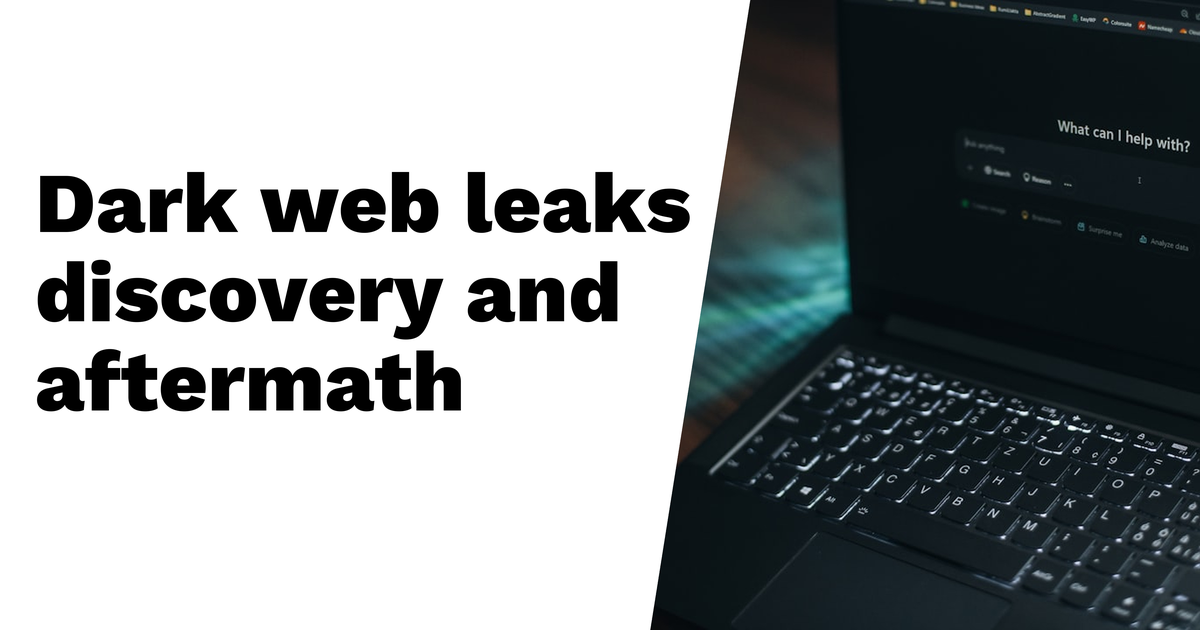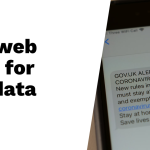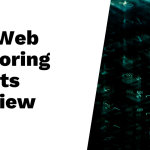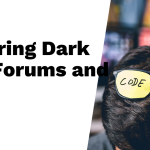Understanding the dark web is crucial as it represents a hidden part of the internet, accessible only through special software like Tor. While it has associations with illegal activities, it serves some legitimate purposes as well. Data leaks on the dark web often originate from breaches, phishing attacks, and malware infections targeting organizations. Commonly leaked data includes sensitive personal information like Social Security numbers and financial details. When leaks are discovered, via monitoring services or cybersecurity reports, organizations must verify their legitimacy and respond swiftly by investigating breaches and notifying affected individuals. Following this, ongoing monitoring of potential leaks becomes essential to manage reputational harm effectively.
Table of Contents
- Understanding the Dark Web
- How Data Ends Up on the Dark Web
- Types of Data Commonly Leaked
- Functionality of Dark Web Leak Sites
- Discovery of Leaks
- What Happens After a Data Leak is Discovered
- Impact of Data Leaks
- Preventative Measures and Recommendations
- Legal Recourse
- Frequently Asked Questions
1. Understanding the Dark Web

The dark web is a unique segment of the internet that requires special software, like Tor, to access. Unlike the surface web, which most people use daily, the dark web is intentionally hidden and offers anonymity to its users. This anonymity is crucial for many, as it allows individuals to communicate securely and evade surveillance from governments and corporations. While it’s often associated with illegal activities, such as the sale of drugs and stolen data, the dark web also serves as a platform for privacy advocacy and freedom of expression, especially in oppressive regimes where such freedoms are limited. For example, activists in countries with strict censorship might use dark web forums to organize protests or share information without fear of reprisal. Additionally, forums on the dark web can foster communities of like-minded individuals discussing various topics, from technology to personal interests. Transactions in this space frequently rely on cryptocurrencies like Bitcoin, which provide a layer of pseudonymity that traditional payment methods cannot. However, it’s important to note that not all dark web sites are unregulated; many have community standards and moderators to maintain order. Despite its risks, there are educational resources available to help users navigate the dark web safely, highlighting the ethical questions surrounding privacy, security, and the balance between freedom and safety.
2. How Data Ends Up on the Dark Web
Data often finds its way onto the dark web through various nefarious activities. One common method is data breaches at corporations, which frequently occur after cyberattacks like ransomware. Here, attackers infiltrate systems, steal sensitive information, and demand payment for its return. Phishing attacks also play a significant role, as they trick individuals into revealing personal information, which can then be sold to the highest bidder on the dark web. Additionally, malware can secretly infiltrate systems to extract data without the user’s knowledge, contributing to the growing pool of leaked information.
Organizations that rely on weak passwords and lack robust security protocols are particularly vulnerable to these attacks. Cybercriminals often exploit human psychology through social engineering tactics, impersonating trusted figures like IT support to gain access to sensitive data. Insider threats also pose a risk, with some employees leaking information for financial gain or even out of malice. Furthermore, third-party vendors can be compromised, leading to leaks of data that companies believed were secure.
Hackers are constantly scanning for vulnerabilities, using automated tools to locate unprotected databases left accessible on the internet. The rise of the Internet of Things (IoT) has introduced new vulnerabilities, as many smart devices lack adequate security measures, making them easy targets for attackers. All these factors contribute to the alarming amount of personal and corporate data that ends up on the dark web.
- Data breaches at corporations often result from cyberattacks like ransomware, where attackers steal sensitive information and demand payment.
- Phishing attacks trick individuals into revealing personal information, which can then be sold on the dark web.
- Malware can infiltrate systems and extract data without the user’s knowledge, adding to the pool of leaked information.
- Weak passwords and lack of security protocols can make organizations vulnerable to data theft.
- Social engineering tactics exploit human psychology to gain access to sensitive data, such as impersonating IT support.
- In some cases, insider threats involve employees who may leak data for financial gain or out of malice.
- Even third-party vendors can be compromised, leading to leaks of data that organizations thought were secure.
- Data can also be obtained through unprotected databases left accessible on the internet, where hackers can find it easily.
- Hackers may use automated tools to scan for vulnerabilities in systems, increasing the chances of successful attacks.
- The rise of the Internet of Things (IoT) has created new vulnerabilities, as many devices lack adequate security measures.
3. Types of Data Commonly Leaked
The dark web is a marketplace for various types of leaked data, and some categories are particularly common. Personal identification information is a prime target, with Social Security numbers being highly sought after for identity theft. Financial information, such as bank account details and credit card numbers, is frequently sold to the highest bidder, allowing criminals to make unauthorized purchases or drain accounts.
Login credentials for email accounts, social media, and other services are often leaked, giving attackers easy access to personal and professional information, which can lead to further fraud. Medical records are also valuable; they contain sensitive data that can be exploited for financial gain or even insurance fraud.
Corporate and government data are major targets as well. Intellectual property and trade secrets can be leaked, putting companies at a competitive disadvantage, while confidential government communications may lead to national security risks. Additionally, corporate data, including employee records and client information, is often compromised in breaches, posing significant risks to organizations.
In the realm of personal data, educational records and student information are increasingly targeted by cybercriminals. Lastly, personal photos and videos can be leaked, leading to risks of blackmail or public shaming. This wide array of leaked data highlights the serious implications of cyber threats in today’s digital landscape.
| Type of Data | Description | Examples |
|---|---|---|
| Personal Identification Information | Highly sought after for identity theft | Social Security numbers, Driver’s license numbers |
| Financial Information | Frequently sold on dark web marketplaces | Bank account details, Credit card numbers |
| Login Credentials | Used for unauthorized access and fraud | Email accounts, Social media accounts |
| Medical Records | Contain sensitive personal information | Health insurance data, Patient records |
| Intellectual Property | Leaked to competitors or sold to highest bidder | Trade secrets, Research and development data |
| Government Data | Confidential communications and security information | Classified documents, Security protocols |
| Corporate Data | Targets include employee and client information | HR records, Client databases |
| User Data | Can be leaked due to security breaches | Behavioral data from apps, Subscription details |
| Educational Records | Increasing targets for cybercriminals | Student grades, Enrollment data |
| Personal Photos and Videos | Used for blackmail or public shaming | Nude images, Private videos |
4. Functionality of Dark Web Leak Sites

Dark web leak sites function as underground marketplaces where stolen data is bought and sold. Cybercriminals use these platforms to trade information anonymously, taking advantage of the dark web’s hidden nature to evade law enforcement. Many of these sites showcase samples of stolen data to entice potential buyers, providing proof of data breaches that can pressure organizations into paying ransoms. Ransomware groups often negotiate payments through these sites, threatening to release sensitive information publicly if their demands are not met. Some leak sites operate on a subscription model, allowing users to access exclusive stolen data for a fee. These platforms also feature forums where hackers discuss techniques and vulnerabilities, fostering a collaborative environment for malicious activities. To facilitate secure transactions, certain leak sites offer escrow services, ensuring that buyers and sellers can complete deals safely. Additionally, these sites can serve as recruiting grounds for new cybercriminals, expanding their networks. Many leak sites employ various methods to remain operational, even after law enforcement attempts to shut them down. Interestingly, some leak sites also act as whistleblower platforms, exposing corporate wrongdoing by sharing sensitive information from within organizations.
5. Discovery of Leaks
Organizations often rely on dark web monitoring services to track their data, aiming to identify any potential leaks associated with their domains. These services utilize automated tools that scan hidden parts of the internet for compromised credentials, allowing firms to react swiftly to breaches. Cybersecurity firms play a vital role in this process, helping organizations discover leaks and assess their impact. Sometimes, reports of leaks come from whistleblowers or investigative journalists looking into security breaches. Additionally, discussions on social media can inadvertently bring leaks to light, as users share their experiences or concerns regarding data security. Some organizations have dedicated teams focused on threat intelligence, which includes monitoring activities on the dark web. Collaborating with law enforcement can also uncover large-scale data sales on dark web marketplaces. Regular security audits are crucial for identifying vulnerabilities before data leaks occur. Moreover, collaboration with other businesses within the same industry can facilitate the sharing of information about potential threats or leaks. However, many organizations lack the necessary resources for effective monitoring, making them susceptible to leaks that may go undetected.
6. What Happens After a Data Leak is Discovered
Upon discovering a data leak, organizations must act swiftly to evaluate the extent of the breach. This involves identifying what specific data has been compromised, which is crucial for understanding potential risks. Legal departments are usually engaged early in the process to clarify obligations related to notification and to ensure compliance with regulations. Meanwhile, IT security teams jump into action to secure systems, patch any vulnerabilities, and prevent further unauthorized access.
In many cases, the law requires organizations to notify affected individuals promptly. This communication is essential as it allows individuals to take protective measures against possible identity theft or fraud. Organizations may also develop public relations strategies to manage their reputation and communicate transparently about the breach, which can help mitigate negative perceptions.
Regulatory scrutiny is often inevitable, as organizations may face investigations and possible fines for failing to safeguard personal data. To understand the breach’s cause and impact, many organizations engage cybersecurity firms for forensic investigations. These firms can provide valuable insights into how the breach occurred and what steps can be taken to prevent future incidents.
To stay ahead of potential threats, companies often institute continuous monitoring of the dark web. This proactive approach helps track stolen data and detect any further attempts to misuse it. Long-term strategies may include revising security policies, enhancing employee training on data protection, and even offering credit monitoring services to affected individuals as a goodwill gesture. These steps not only help in recovery but also aim to restore trust among customers and stakeholders.
7. Impact of Data Leaks
Data leaks can have serious consequences for both individuals and organizations. Financially, the costs can be immense, with expenses for remediation and legal fees quickly adding up. Companies may see a drop in market value as investors lose faith in their ability to protect sensitive information. Reputational damage is another critical factor, as loss of customer trust can lead to diminished sales and long-term business relationships. For individuals, the risks include identity theft, which can result in significant financial losses and emotional distress. Victims may feel anxious and fearful about their privacy being compromised. Furthermore, organizations may face lawsuits from affected customers, compounding their legal troubles and financial strain. Following a breach, increased scrutiny from regulatory bodies may lead to higher compliance costs, and rising cybersecurity insurance premiums can further impact financial stability. In some situations, data leaks reveal systemic issues within organizations, prompting them to conduct internal investigations and make necessary changes. Overall, the landscape of cybersecurity may shift, with a growing demand for stronger security solutions in response to these breaches.
8. Preventative Measures and Recommendations
To safeguard against data leaks, organizations and individuals should adopt several key practices. Implementing strong password policies, which include complexity requirements and regular updates, is an effective way to mitigate risks. Encouraging multifactor authentication adds another layer of security, making it harder for unauthorized users to gain access to sensitive accounts. Regular monitoring of financial accounts and credit reports helps individuals detect any unauthorized activities early on, potentially preventing further damage.
For organizations, conducting cybersecurity training for employees can elevate awareness of potential threats, ensuring that everyone understands how to recognize phishing attempts and other vulnerabilities. Regular security audits are essential to identify weaknesses in systems and confirm compliance with security best practices. Developing a robust incident response plan enables organizations to act quickly if a data leak occurs, minimizing the impact of such incidents.
Investing in advanced security technologies, like intrusion detection systems, can help spot threats before they escalate. Collaborating with cybersecurity firms can provide additional expertise and resources to strengthen defenses against data leaks. Finally, fostering a culture of security within organizations encourages employees to take ownership of data protection. Regularly updating software and systems is also crucial, as it helps close security gaps that cybercriminals might exploit.
9. Legal Recourse
Victims of data breaches often seek legal options to address the harm caused by these incidents. One common approach is to file complaints with regulatory agencies that oversee data protection. For those affected by large-scale breaches, class action lawsuits can provide a way to seek compensation collectively. Legal frameworks like the General Data Protection Regulation (GDPR) offer specific protections, allowing individuals to pursue recourse when their data is mishandled.
Organizations that fail to protect sensitive data adequately may face legal penalties, which can lead to significant financial liabilities. Additionally, if third-party vendors are found responsible for a breach, contractual obligations may come into play, complicating the legal landscape further. Consulting with legal professionals who specialize in data privacy is essential for victims to understand their rights and the options available to them.
Victims can potentially recover damages related to identity theft and other losses through civil suits. In some jurisdictions, laws require organizations to inform affected individuals of data breaches within a specific timeframe, ensuring that victims are aware of the risks they face. Legal recourse can vary significantly based on local laws, making it crucial for individuals to be informed about the regulations in their area. Participating in settlement discussions after a breach can also offer some compensation, depending on the specifics of the case.
Frequently Asked Questions
How do experts find leaks on the dark web?
Experts use special tools and techniques to scan the dark web, checking for stolen data, usernames, and passwords. They look for unusual activity that might indicate a data leak.
What types of information are usually found in dark web leaks?
Dark web leaks often contain sensitive information like personal details, credit card numbers, and company secrets. This information can be used for identity theft or fraud.
What do organizations do when they discover a leak?
When a leak is discovered, organizations typically investigate the source, notify affected individuals, and take steps to secure their systems to prevent future leaks.
Can leaked information be removed from the dark web?
Removing leaked information from the dark web is challenging. Once data is out there, it’s tough to control. However, organizations can monitor and report illegal listings to try and minimize exposure.
What should I do if my information is leaked on the dark web?
If your information is found on the dark web, you should change your passwords, enable two-factor authentication, and possibly notify your bank or credit reporting agency to protect yourself.
TL;DR The dark web is a hidden part of the internet that requires specific software to access. Data often leaks to the dark web through breaches, phishing, and malware. Commonly leaked data includes personal identification and financial information. Dark web leak sites publish stolen data and may employ tactics like double extortion. Organizations discover leaks through monitoring services and alerts. After a leak, they must verify its validity, notify affected individuals, and monitor for further issues. Data leaks can lead to financial loss and emotional distress. To prevent leaks, strong passwords and proactive security measures are essential. Victims may have legal recourse through class action lawsuits.





